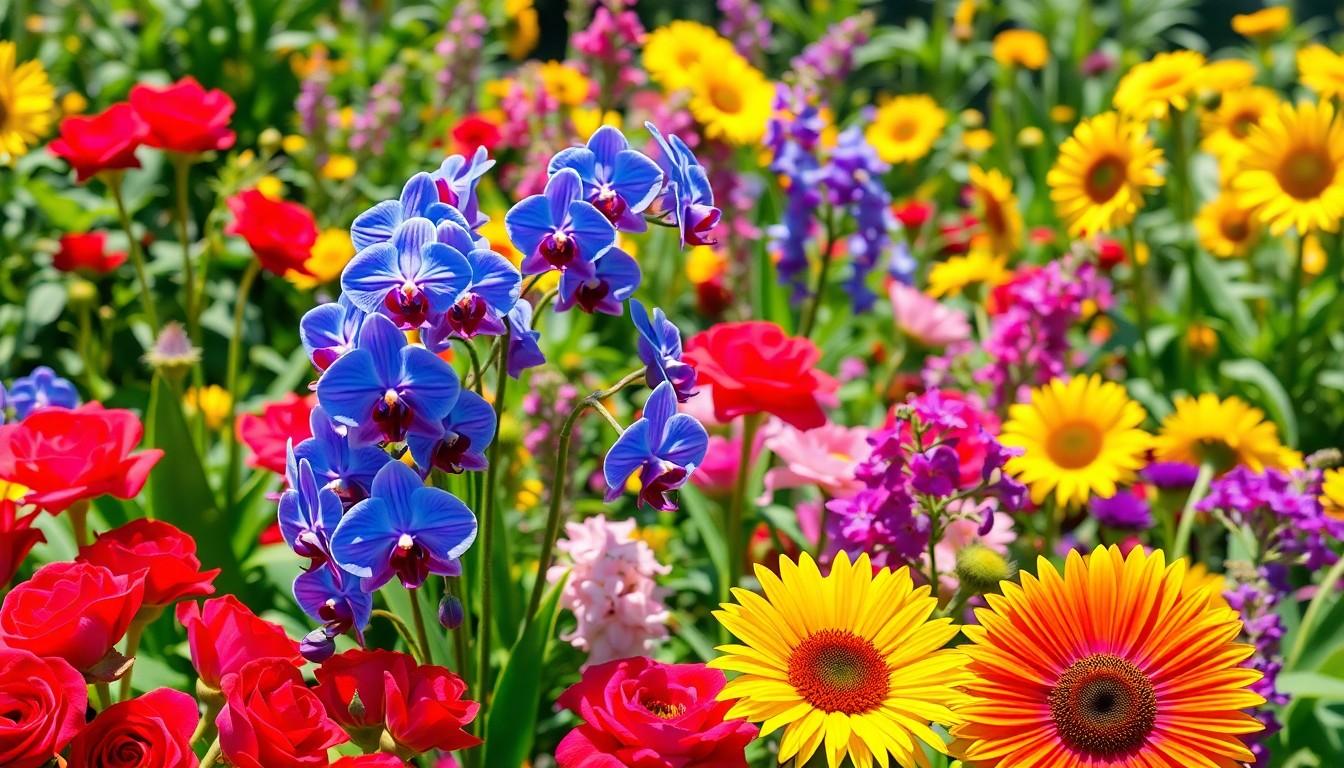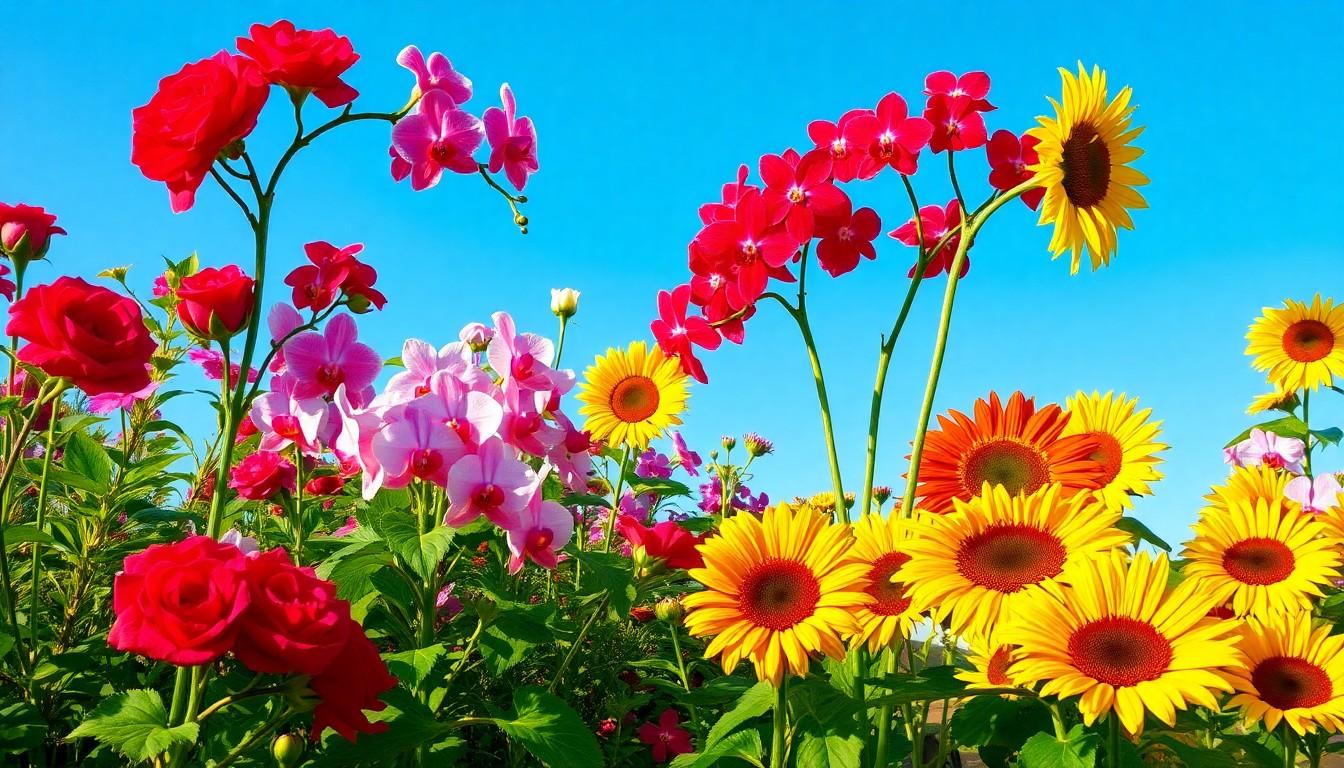Flowers have a magical way of brightening up any space, and some are so stunning they could make even the grumpiest cat crack a smile. From vibrant petals to enchanting fragrances, the world’s most beautiful flowers don’t just bloom—they steal the show. Whether you’re planning a garden makeover or just looking to impress your Instagram followers, knowing which flowers to choose can make all the difference.
In this delightful journey through nature’s palette, we’ll explore the top 10 most beautiful flowers in the world. These floral wonders are not just eye candy; they come with fascinating stories and unique characteristics that’ll leave you in awe. So grab your gardening gloves and prepare to be inspired—because who wouldn’t want a little more beauty in their life?
Overview of Beautiful Flowers
Flowers captivate with their vibrant colors and delicate forms. These natural beauties thrive in diverse environments, from tropical jungles to temperate gardens. Many species attract pollinators, playing a vital role in ecosystems. Their fragrances enhance experiences, creating lasting memories.
Beauty varies with personal preferences, yet certain flowers consistently stand out. Roses symbolize love with their elegant petals and enchanting scents. Orchids showcase intricate designs, often seen as a sign of luxury. Sunflowers brighten landscapes with their large, cheerful heads.
Cultural significance often elevates a flower’s status. Cherry blossoms represent renewal and beauty in Japanese culture. Lilies, associated with purity, appear frequently in art and literature. Tulips signal springtime, captivating enthusiasts worldwide with their shape and colors.
Gardening interests soar around these beautiful flowers. Individuals seek knowledge on cultivation techniques to grow stunning displays. Seasonal blooms add excitement, with options varying from annuals to perennials. Choosing the right flowers enhances outdoor aesthetics and personal spaces.
Each flower contributes uniquely to its environment, enhancing nature’s artistry. Observing how different species interact creates appreciation for biodiversity. Enthusiasts explore these floral wonders, crafting arrangements, or capturing them in photographs. Embracing beauty, individuals discover joy in the simple act of nurturing plants.
Criteria for Beauty

Several factors contribute to the beauty of flowers, including color, shape, and structure. These elements create an overall impression that captivates and inspires.
Color and Vibrancy
Color plays a crucial role in defining a flower’s beauty. Bright reds, deep blues, and radiant yellows attract attention and evoke emotions. For instance, roses come in various shades that symbolize love and passion. The vibrant hues of orchids evoke luxury, while sunflowers radiate happiness and warmth. Flowers blooming in unique combinations amplify their visual appeal, captivating everyone nearby. Gardens filled with colorful flowers often create stunning backdrops, inviting admiration and tranquility. Additionally, seasonal transitions enhance color palettes, allowing nature to display an ever-changing beauty throughout the year.
Shape and Structure
Shape and structure also influence a flower’s allure. Unique petal arrangements can create striking silhouettes, enhancing visual interest. For example, the intricate symmetry of daisies creates a stunning effect, while the exotic shapes of bird of paradise flowers inspire awe. Some flowers feature cascading petals, adding a sense of elegance and grace. Others may boast robust structures, exhibiting strength alongside delicate beauty. The combination of various shapes in a garden allows for a dynamic and diverse floral landscape that draws the eye. Each flower’s individuality contributes to the overall enchanting aesthetic, making them cherished elements in nature and design.
Top 10 Most Beautiful Flowers in the World
Flowers enhance spaces and evoke beauty through their vibrant colors and unique shapes. Here’s a closer look at ten of the most beautiful flowers in the world.
Rose
Roses symbolize love and passion, captivating many with their layers of delicate petals. They come in various colors, each representing different emotions, from deep red for romance to soft pink for admiration. Their rich fragrance adds to their allure, making them a popular choice for gardens and bouquets.
Orchid
Orchids exude elegance and luxury, featuring intricate patterns and shapes. With over 25,000 species, they showcase diverse colors from stark whites to vibrant purples. Their unique blooming habits and exotic appearances draw photographers and plant enthusiasts alike, celebrating their beauty.
Cherry Blossom
Cherry blossoms, celebrated in Japanese culture, signify renewal and the fleeting nature of beauty. Their soft pink petals create stunning visuals during spring, captivating viewers during festivals. This flower’s cultural significance and breathtaking displays inspire artists and nature lovers worldwide.
Lotus
Lotus flowers embody purity and resilience, often found in serene waters. They bloom with striking colors, ranging from white to pink, symbolizing enlightenment. This flower’s ability to rise above murky waters enhances its allure, representing inner strength and beauty.
Tulip
Tulips appear as a hallmark of spring, blooming in various colors and forms. These flowers boast smooth, elongated petals that create stunning landscapes. Originating from Central Asia, they have become symbolic of profit and beauty, enticing gardeners everywhere.
Bird of Paradise
Bird of paradise flowers resemble exotic birds in flight, showcasing vibrant orange and blue hues. Their unique shape adds dramatic flair to gardens, attracting attention. They thrive in tropical climates, bringing a touch of the extraordinary to landscapes with their striking appearance.
Dahlia
Dahlias shine with diverse forms and sizes, featuring stunning blooms that can reach 12 inches in diameter. The captivating color palettes offer endless combinations, appealing to garden enthusiasts. Their elegant shape and impressive variety enhance garden displays throughout the summer.
Lavender
Lavender’s soothing fragrance captivates the senses, making it a favorite in aromatherapy. Its purple spikes attract pollinators and bloom from late spring to early summer. Beyond beauty, this flower holds practical uses; culinary and medicinal applications make it a versatile addition to any garden.
Hydrangea
Hydrangeas showcase large, round flower clusters, transforming landscapes with their bold colors. These blooms change hues depending on soil pH; acid soils yield blue blooms while alkaline soils produce pink. Their ability to adapt and thrive makes them enduring favorites among gardeners.
Hibiscus
Hibiscus flowers stand out with their large, trumpet-like shapes and vibrant colors. Thriving in warm climates, they add tropical charm to gardens and landscapes. Their beauty not only draws the eye but also attracts various pollinators, enhancing the surrounding ecosystem.
Care Tips for These Flowers
Caring for beautiful flowers requires understanding their unique needs. Specific growing conditions and maintenance tips make a significant difference in their health and vibrancy.
Growing Conditions
Each flower type thrives in distinct environments. Roses flourish in well-drained soil and enjoy full sun for at least six hours daily. Orchids prefer a warm, humid atmosphere, typically found in areas with indirect light. Cherry blossoms require well-drained soil, with good airflow to prevent disease. Lotus flowers benefit from full sun and a still water source, while tulips do best in well-drained, sandy soil. Bird of paradise enjoys tropical climates with plenty of sunlight, while dahlias thrive in rich, moist soil with excellent drainage. Lavender prefers dry, sandy conditions and abundant sunlight. Hydrangeas grow well in moist, slightly acidic soil, whereas hibiscus requires warm temperatures and ample water to flourish.
Maintenance Tips
Proper maintenance ensures flowers stay healthy and vibrant. Regular watering is essential, especially during dry spells, as many flowers prefer moist soil. Pruning helps promote growth; roses require trimming of dead branches. Fertilizing every few weeks can boost flower production for species like dahlias and tulips. Pest control measures, such as organic insecticides, keep harmful insects at bay. Mulching around flowers retains moisture and suppresses weeds, benefiting varieties like hydrangeas. Regular deadheading encourages blooming in species like lavender and hibiscus. Attention to seasonal changes can also help, adjusting water and nutrients based on the flower’s life cycle.
Conclusion
Exploring the top 10 most beautiful flowers in the world reveals the incredible diversity and charm these blooms offer. Each flower brings its own unique allure and significance, enriching gardens and landscapes alike. Whether one is drawn to the romantic rose or the exotic bird of paradise, there’s a flower to match every taste and occasion.
Cultivating these floral beauties not only enhances outdoor spaces but also fosters a deeper connection to nature. By appreciating their individual characteristics and understanding their care requirements, anyone can enjoy the vibrant colors and enchanting fragrances that these flowers provide. Embracing the beauty of flowers is a rewarding journey that brings joy and inspiration to everyday life.

